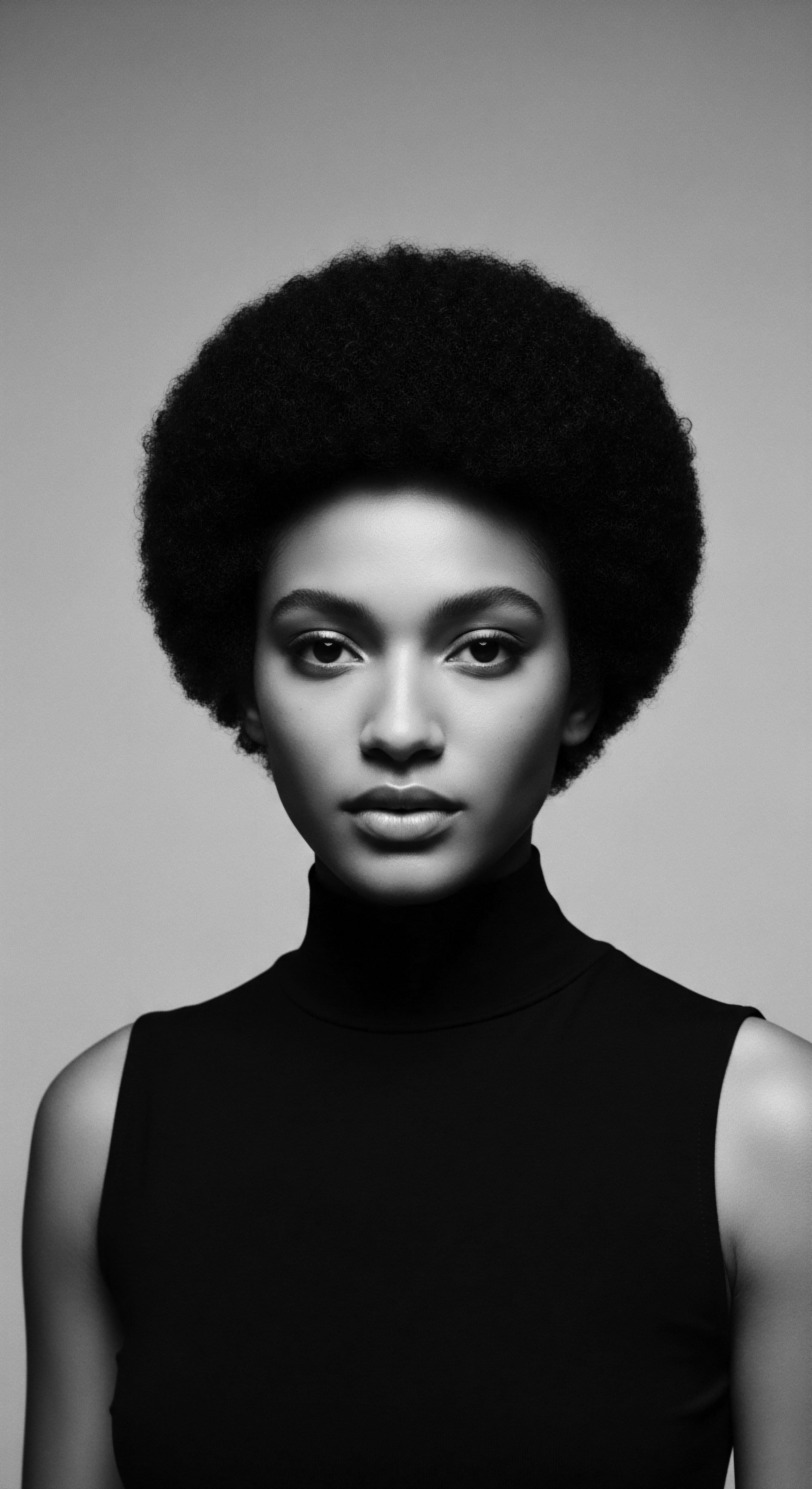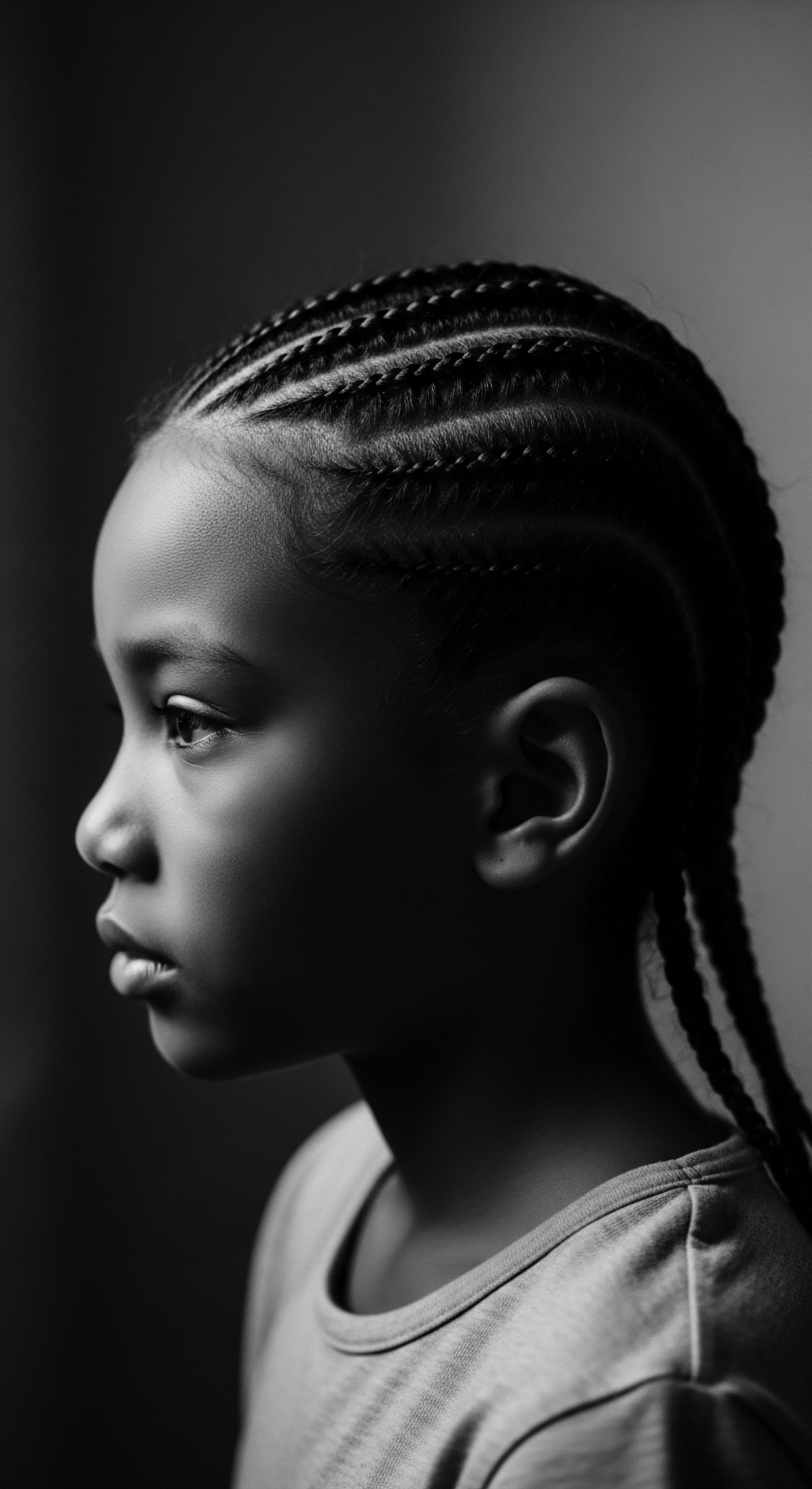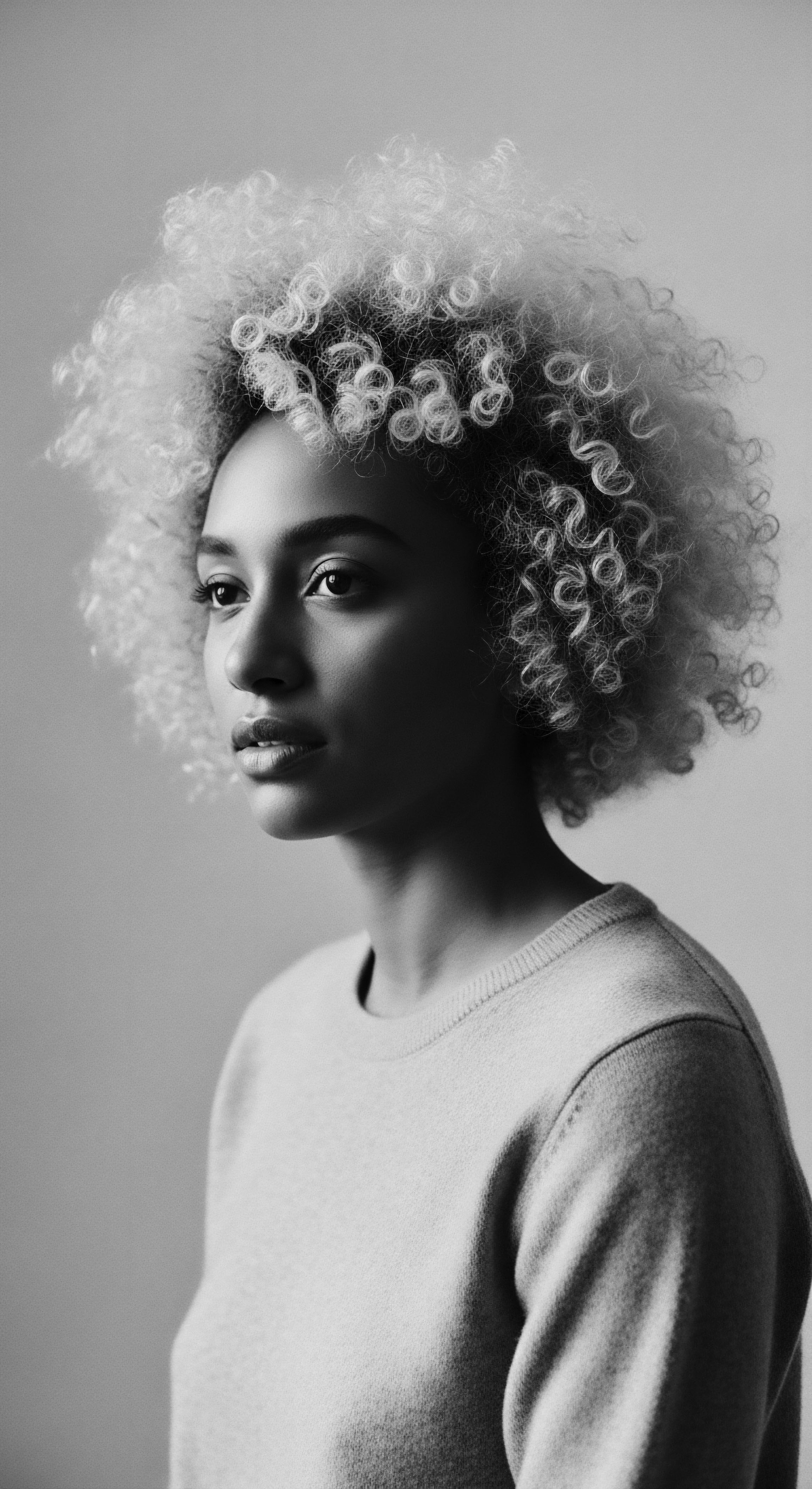
Roots
For those of us whose lineage holds the rich, winding narratives of textured hair, the act of oiling strands is more than a mere step in a grooming routine. It is a dialogue with ancestors, a ritual whispered through generations, a silent understanding of what our unique curls and coils demand. This tradition, deeply rooted in the soil of our heritage, speaks to an innate wisdom about the very biology of our hair, a wisdom passed down long before microscopes revealed cellular structures. Our hair, a living crown, carries not only our history but also its own biological blueprint, a design that responds uniquely to the touch of an oil.

What is the Biological Reason for Oiling Textured Hair?
The science of textured hair reveals a profound biological imperative for oiling. To truly grasp this, one must look at the hair shaft itself, a marvel of biological engineering. Unlike straight hair, which tends to be round or slightly oval in cross-section, textured hair — particularly coily and kinky hair types — emerges from elliptical or flat follicles.
This unique shape causes the hair strand to grow in a series of twists, bends, and curves. These helical formations, while granting our hair its striking versatility and volume, also create inherent points of weakness along the fiber.
Consider the cuticle, the outermost protective layer of the hair strand, a mosaic of overlapping scales resembling shingles on a roof. In straight hair, these scales lie relatively flat, allowing natural scalp oils, known as sebum, to travel down the shaft with relative ease. However, for textured hair, the very geometry of the strand, with its spirals and turns, means sebum struggles to navigate these intricate pathways.
The natural lipids produced by the scalp simply cannot lubricate the entire length of the hair, leading to an inherent dryness, especially at the ends. This structural reality is a primary biological reason for the need for external oils.
Textured hair’s distinct helical structure inherently hinders natural scalp oils from lubricating the entire strand, necessitating external oil application.

The Cuticle and Lipid Content in Textured Hair
Despite often being characterized as dry, textured hair possesses a higher overall lipid content compared to other hair types. These lipids, molecules like fatty acids, ceramides, and cholesterol, form a laminated structure within the hair, creating a barrier against environmental factors. The integral hair lipids, situated within the cuticle layers, maintain hair integrity, hydrophobicity, and moisture.
Yet, the biomechanical characteristics of African hair, specifically its curvature and spiral follicles, contribute to areas of weakness. These structural traits make the hair more fragile and prone to breakage, which further exacerbates its perceived dryness.
The epicuticle, the outermost layer of the cuticle, plays a role in regulating hair lubrication and serving as a barrier. Surface lipids and protein interactions are vital in determining the hair fiber’s overall structure. When this delicate lipid barrier is compromised, hair becomes more susceptible to damage and moisture loss.
Oiling, then, acts as a supportive measure, supplementing the hair’s natural, yet often unevenly distributed, lipids. It helps to reinforce the external lipid layer, smoothing the cuticle and providing a protective shield.

Ritual
The application of oils to textured hair transcends simple cosmetic practice; it is a ritual, a connection to ancestral wisdom that recognizes hair as a profound extension of self and spirit. Generations have known, instinctively, that our coils thirst for external sustenance, a knowledge passed down through the soft hands of matriarchs and the quiet wisdom of shared care. This deep understanding, born of necessity and tradition, has shaped how oils have been used for centuries, weaving them into the very fabric of our cultural practices and styling heritage.

What Historical Practices Inform Contemporary Oiling Rituals?
Across African societies, hair care practices were intricate, communal, and often imbued with spiritual significance. Before the transatlantic slave trade, hair was a symbol of status, identity, age, and spiritual connection. The meticulous processes of braiding, twisting, and adornment often involved the application of natural butters, herbs, and oils to promote health and retain moisture. In communities like the Himba of Namibia, a paste of butterfat and ochre, called Otjize, is traditionally applied not only for its cultural symbolism but also to protect hair from sun and insects, highlighting a holistic approach to hair preservation rooted in ancestral wisdom.
During the brutal era of slavery, captive Africans were stripped of their traditional tools, oils, and the communal rituals that defined their hair care. Their heads were often shaved as an act of dehumanization. Yet, despite these immense hardships, ingenuity and resilience prevailed.
Enslaved people often resorted to whatever was available – bacon grease, butter, kerosene – as desperate attempts to condition and protect their hair, even cornmeal served as a dry shampoo. These acts, born of unimaginable deprivation, underscore the deep-seated understanding of textured hair’s need for lubrication and protection, even in the absence of traditional means.
- Shea Butter ❉ A staple across West Africa for centuries, extracted from shea nuts, used to soften, condition, and protect hair and skin from harsh environmental conditions.
- Coconut Oil ❉ Widely used in various African and Indian cultures, valued for its deep conditioning properties and ability to penetrate the hair shaft.
- Castor Oil ❉ Applied by ancient Egyptians for hair growth and soothing skin ailments, now recognized for its thick consistency and fatty acid content that strengthens hair.
- Argan Oil ❉ Often termed “liquid gold,” used to restore moisture and shine, particularly beneficial for damaged hair due.
- Olive Oil ❉ Utilized in ancient Egyptian and Greek practices, known for its antioxidants and ability to seal the hair cuticle.
From protective styles to ceremonial adornments, oiling has long been an integral part of textured hair heritage, preserving moisture and expressing cultural identity.

How do Different Oil Types Serve Textured Hair’s Needs?
The vast spectrum of oils, both historically and in contemporary practice, caters to the diverse needs of textured hair, often categorized by their ability to penetrate the hair shaft or act as a sealant. Oils function primarily as emollients, softening and nourishing the hair, and importantly, they help seal moisture into the hair, rather than directly adding hydration. For instance, lighter oils with smaller molecules, such as Jojoba Oil or Grapeseed Oil, are often preferred for low porosity hair, where cuticles are tightly closed, to prevent product buildup and allow for better absorption.
Conversely, hair with high porosity, characterized by raised cuticles that easily allow moisture to escape, benefits significantly from heavier, sealing oils. These oils, including Shea Butter or Castor Oil, create a more substantial barrier, helping to lock in moisture effectively and reduce friction by smoothing the cuticle. The choice of oil often mirrors ancestral practices, where communities utilized locally available botanicals that suited their specific environmental conditions and hair characteristics. This adaptive wisdom reflects a continuous cycle of care and response to the hair’s intrinsic biological needs.

Relay
The journey of understanding oil’s role in textured hair care extends beyond ancient applications, moving into the deeper scientific explanations that affirm ancestral wisdom. The act of anointing hair with oils, a practice woven into the fabric of our heritage, finds its scientific validation in the very biophysics of our coils. It is a dialogue between the observed and the understood, where traditional knowledge of hair health finds its echo in modern research.

What Biological Mechanisms Explain Oil’s Protective Action on Textured Hair?
The biological reason for oiling textured hair centers on its unique structural vulnerabilities and its battle against dehydration and mechanical stress. Textured hair, with its inherent twists and turns, is susceptible to mechanical damage. Combing, brushing, and even simple movement can create shear forces that lead to crack formation within the hair fiber, particularly in dry hair.
These cracks can propagate through the cell membrane complex and between cuticle cells, leading to breakage. Oils intervene in this delicate balance, acting as a crucial line of defense.
The primary mechanisms involve lubrication, moisture retention, and cuticle protection. Oils provide a lubricating layer, reducing friction between individual hair strands and between the hair and styling tools. This “slip” minimizes mechanical stress during detangling and manipulation, which is a major contributor to breakage in textured hair. Furthermore, oils work by coating the hair shaft, forming a hydrophobic barrier that seals the cuticle.
This barrier prevents excessive moisture loss, a common challenge for textured hair where natural sebum struggles to travel down the spiraled strands. This sealing action is especially vital in managing Hygral Fatigue, the weakening of hair strands from repeated swelling and contracting as they absorb and release water. By regulating moisture entry and exit, oils help maintain the hair’s elasticity and resilience.
| Aspect of Oiling Moisture Retention |
| Ancestral Understanding Belief that oils keep hair from becoming dry and brittle, especially in arid climates. |
| Contemporary Scientific Explanation Oils form a hydrophobic barrier, sealing the hair cuticle and preventing moisture evaporation. |
| Aspect of Oiling Strength and Breakage Prevention |
| Ancestral Understanding Observation that oiled hair was less prone to snapping during manipulation or styling. |
| Contemporary Scientific Explanation Oils lubricate the hair, reducing friction and mechanical stress, thereby minimizing crack formation and breakage. |
| Aspect of Oiling Scalp Health |
| Ancestral Understanding Oils were used in scalp massages to promote growth and soothe irritation. |
| Contemporary Scientific Explanation Specific oils (e.g. coconut, tea tree, rosemary) possess antimicrobial or anti-inflammatory properties, supporting a healthy scalp microbiome and circulation. |
| Aspect of Oiling Shine and Appearance |
| Ancestral Understanding Oiled hair had a desirable luster and vibrancy, reflecting light more beautifully. |
| Contemporary Scientific Explanation Oils smooth the hair cuticle, creating a more even surface that reflects light more effectively, resulting in enhanced shine and reduced frizz. |
| Aspect of Oiling The enduring legacy of oiling textured hair rests upon a rich intersection of inherited wisdom and validated scientific principles. |

How do Lipids within the Hair Structure Relate to Oiling’s Efficacy?
The hair fiber naturally contains lipids, which are crucial for maintaining its structural integrity and protective barrier. These internal lipids, found in the cuticle and cortex, contribute to the hair’s hydrophobicity and elasticity. However, factors such as environmental exposure, mechanical manipulation, and chemical treatments can deplete these natural lipids, compromising the hair’s defense system.
This is where external oils play a reparative role, supplementing the hair’s natural lipid content. Some oils, such as coconut oil, have a molecular structure that allows them to penetrate the hair shaft, reducing protein loss during washing and bolstering the hair’s internal strength.
The presence of ceramides, a specific type of lipid found in the hair cuticle, is particularly pertinent. Ceramides form a waxy layer that helps maintain hair structure and strength by binding the cuticle layers together, acting as a protective barrier. When this ceramide layer is damaged, hair becomes dry, brittle, and susceptible to breakage.
Applying oils rich in fatty acids and other nourishing compounds can mimic and support these natural lipids, thereby fortifying the hair’s protective barrier and improving its overall health and appearance. This biological reinforcement is a testament to the foresight embedded within historical oiling practices.
Oiling textured hair biologically reinforces its natural lipid barrier, providing lubrication, preventing moisture loss, and mitigating structural damage inherent to its unique shape.
Historically, indigenous communities across various continents intuitively understood this protective aspect. In the traditional practices of the Basara Tribe of Chad, the consistent application of an herb-infused oil and animal fat mixture, often referred to as Chebe, was combined with protective braiding. This practice is strongly associated with remarkable length retention, highlighting a practical, ancestral application of principles that modern science now attributes to reduced mechanical damage and sustained moisture. This example from the Basara people stands as a powerful testament to the efficacy of traditional oiling within textured hair heritage, where observed benefits preceded scientific explanations, securing a legacy of care.

Reflection
To oil textured hair is to engage in an act that echoes across time, a profound conversation between our biological needs and our deep cultural memory. It is a moment where the scientific understanding of a helical strand, its unique porosity, and its lipid hunger converges with the wisdom of those who came before us, those who navigated landscapes with only the sun and the soil as their guides. The biological reasons for oiling are, at their heart, the very same reasons our ancestors intuitively reached for shea, for castor, for the various oils gifted by the earth.
This enduring practice is not a mere relic of the past; it is a living, breathing archive, perpetually instructing us. Each smooth application, each gentle massage, is a reaffirmation of the soul of a strand, acknowledging its resilience, its beauty, and its profound connection to our collective heritage. Oiling becomes a tangible link, binding us to a legacy of self-care and communal bonding that transcended adversity. It reminds us that our hair, in all its coiled glory, is a testament to survival, creativity, and an unbroken chain of generational wisdom, a testament to its vibrant lineage.

References
- Kasiyasi, A. C. & Munjoma, T. (2024). The Genomic Variation in Textured Hair ❉ Implications in Developing a Holistic Hair Care Routine. MDPI.
- De la Mettrie, R. et al. (2020). Defying Damage ❉ Understanding Breakage in Afro-textured Hair. Cosmetics & Toiletries.
- Robins, C. (2025). Hair Care Practices from the Diaspora ❉ A Look at Africa, America, and Europe. AfroTech.
- Gavazzoni Dias, M. F. (2015). Hair Cosmetics ❉ An Overview. International Journal of Trichology, 7(1), 2-15.
- Dershem, J. (2023). Chemistry of Wellness ❉ Hair and Hair Care. ACS Publications.
- Porwal, S. et al. (2016). Hair Oils ❉ Indigenous Knowledge Revisited. International Journal of Trichology, 8(3), 101-106.
- Byrd, A. D. & Tharps, L. D. (2001). Hair Story ❉ Untangling the Roots of Black Hair in America. St. Martin’s Press.
- Patel, S. et al. (2023). Are Ceramides Good for Hair? Dercos by Vichy.
- McMichael, A. J. (2023). What Every Dermatologist Must Know About the History of Black Hair. Journal of the American Academy of Dermatology.
- Scherer, A. (2022). Hair porosity – helpful tips for your curly & wavy hair care routine. Lockenbox.com.
- Anigbogu, C. & Okafor, J. (2024). Genomic Variation in Textured Hair ❉ Implications for Holistic Hair Care. Preprints.org.
